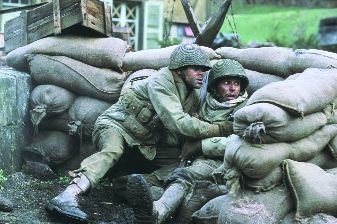Second-class soldiers

Nominated for an Academy Award for best foreign-language film, Days of Glory has received plenty of praise for its sometimes stirring story of North Africans fighting for France during World War II. But far more attention has been paid to its underlying goal of getting France to reinstate pensions for the men who fought for the motherland but had their benefits slashed or eliminated once their home countries gained independence and were no longer part of the French empire.
There are some good movies with such a clear agenda at the core. Some, like Errol Morris’s The Thin Blue Line and Barbara Kopple’s pro-union documentaries (Harlan County U.S.A. and American Dream), were made in the hope that the films could sway the powers-that-be, especially if they generated pressure from the public. The trick, however, is not to turn the film into an occasion for preaching—to make the point without leaving hammer marks on the audience’s scalp.
The French title of Days of Glory is Indigènes, or “Natives,” which was a derogatory term for the dark-skinned North Africans who headed north to fight the Nazis for France. The French saw these men as good enough to bleed and die for France, but not fair-skinned enough to marry their women or live on their wide streets.
The tale, which is told in the fashion of a traditional World War II film, begins with the gathering of young soldiers. Army recruiters wave the flag of France and appeal for their “blood” to keep that flag flying free. We gradually meet the key players in the drama, a quartet of soldiers who represent various elements of foreign resentment and naïveté. One longs to move up the chain of command, another falls in love with a mature Frenchwoman, a third adopts the stern sergeant as his father figure, while a fourth scavenges what he can from the dead bodies of the enemy and comrades alike. What they share is the understandable but unrealistic hope that France will appreciate the sacrifices they have made and reward them accordingly—or at least treat them as equal to any Frenchman.
The film borrows large hunks from other WWII movies, most notably Steven Spielberg’s Saving Private Ryan and Sam Fuller’s The Big Red One. It also echoes Stanley Kubrick’s World War I film Paths of Glory in the way that it indicts the French military brass. In Kubrick’s film it is the prejudices of class that leads the poor foot soldiers into taking the fall for the generals’ mistake. In Days of Glory, it is a racial divide that leads to the tragic disillusionment of these dedicated men.
The film employs an episodic style, moving from recruitment to boot camp to barracks to foxhole to death on the field of battle. In between are personal battles over leaves, promotions and even which soldiers will receive fresh tomatoes at dinner. Once the battles come hot and heavy, director Rachid Bouchareb and screenwriter Olivier Lorelle use an effective transitional device: a shadow of a cloud crosses a battlefield, turning the picture from black and white to color, as if promising that the scene will soon be drenched in blood.
It is a promise that the filmmakers keep. The battle scenes, some of the movie’s more effective moments, include a lengthy third-act finale in which the fighting moves from house to house and doorway to doorway. The film’s greatest strength, however, lies in the performances by the ensemble of relatively unknown actors, who work together like a chorus to make us feel their anguish.
What drags the film down is its insistence on framing the battle for respect and recognition in such rudimentary fashion, ignoring more complex questions. To guard against this, it might have borrowed from yet another WWII film, Terrence Malick’s The Thin Red Line, which employed voice-overs to scour the minds of its characters as they fought and died. Such an approach might have allowed this movie to embrace even larger mysteries, such as why these men would be willing to shed their blood for a country that promised liberty, fraternity and equality but relegated them to second-class status.





